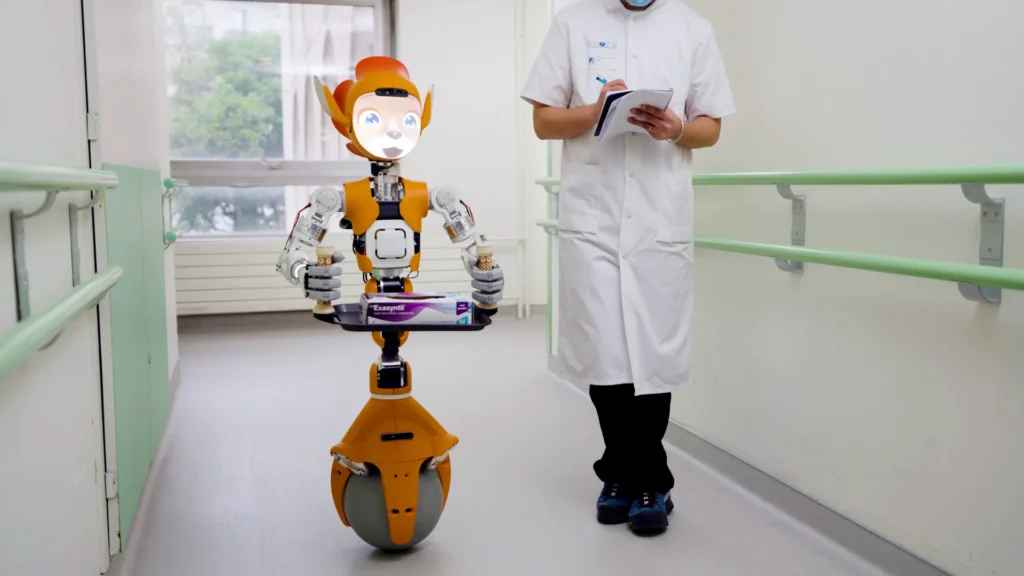
In a post last month, I wrote about some of the trends and fads that have impacted healthcare facility design and construction over the past 20 years that Sheila Cahnman and I spoke about in our presentation at the Healthcare Design Expo + Conference in October.
We wrapped up our presentation with some current healthcare topics and emerging design responses that could become lasting trends — or short-term fads.
Technology: AI
Artificial Intelligence (AI) is transforming healthcare delivery by acting as a foundational technology across various domains, supporting diagnostics, personalized treatment plans, operational efficiency, and patient engagement. This is impacting everything from physical layout and patient flow to how spaces are managed and connected.
AI can adjust lighting, temperature, and noise levels in patient rooms creating more personalized, comfortable environments. AI-driven entertainment and information systems can direct patients to fun stuff and resources they might not know existed.
In addition, emerging smart room technologies like integrated white boards and corridor room signage can now be fully integrated with electronic health records and other systems. These can automatically provide safety protocols, medications, and an integrated schedule of patient activities.
Technology: Robots
And guess what? The robots are coming. Well, they’re here, actually. Robotics for surgical assistance have been around for a while but are continuing to develop in sophistication.
The Automated Guided Vehicles (AGV) that only had prescribed routings and tasks have become, through the use of AI, AMRs that can be given instructions for delivery of materials and pharmaceuticals to precise locations. The next evolution is the humanoid robot which can replace mundane tasks such as passing food trays.
I don’t know about you, but those humanoid robots kinda creep me out.
Access to Care: Retail Repurposing
The trend to provide convenient access both to primary and specialty care is driving innovative solutions such as retail repurposing.
While new construction in healthcare has slowed with the rise of lending and construction costs, many healthcare providers are finding that converting vacated retail space can be an affordable alternative to building a ground-up facility, and at the same time offer patients easier, more convenient access to the healthcare services they need.
Yep. That old Bloomingdale’s store in your mall? It’s now a mixed-use building with a clinic, gym, and event space.
Retail repurposing is great because it allows for speed to market and puts healthcare facilities in prime locations. These projects can also offer inherent advantages when it comes to zoning and local permit approvals.
Access to Care: Hospital at Home
Don’t want to go to the hospital? Hospital at home is another model that makes access to care easier.
With advances in technology, a focus on patient-centered care, and new reimbursement policies, hospital-at-home is not only viable but also a promising approach to healthcare delivery that many patients and providers are now embracing. This is a welcome shift towards more flexible, scalable, and humane care that meets patients where they are.
Being a Better Corporate Citizen: ESG Policies
I’ve written about this before, but many of the healthcare REITS that fund capital projects want to be better corporate citizens, so they are looking for organizations that have strong ESG (Environmental, Social, Governance) policies.
For that reason, many hospitals and healthcare organizations are developing ESG policies. Building design and construction can help support ESG policies in many ways.
Being a Better Corporate Citizen: Environmental
To meet their ESG goals, most hospitals and health systems are only focused on reducing their energy and water consumption – the operational carbon of their buildings. A few are also trying to reduce the embodied carbon footprint of their exterior building materials.
But get this. Due to the number of renovations over a hospital’s lifespan, the embodied carbon footprint of interiors may be responsible for emissions at least equal to or more than those from the building structure or envelope.
That’s why it’s also important to reduce embodied carbon in interiors, which can be achieved by choosing materials and products that have a low carbon footprint. Reusing materials, using locally sourced materials, and designing for flexibility are also effective strategies.
Being a Better Corporate Citizen: Social
I want to see more hospitals and health systems addressing the Social aspect of ESG through facility design. One way to do this is to design spaces for equity, diversity, and inclusion. This means creating physical environments in which everyone is welcomed, respected, supported, and valued.
It also means using ethically sourced materials.
Global laws forbid the use of slave labor in the built environment, yet the materials that go into our buildings – like fiber and textiles, bricks, stone, timber, and glass are heavily reliant on forced labor.
If you’re wondering how to evaluate whether a material is ethically sourced, check out Design for Freedom’s website. They’ve developed a toolkit that has many resources and strategies.
Trend or Fad?
It’s hard to say whether these are long term trends, or short-lived fads. Fads are sometimes overreactions to the healthcare issue “du jour.”
And there will always be unknown factors. The ultimate test it the test of time.
P.S. Please do me a favor — if you liked this post and like this blog, please share it with others by sending them the link or posting it on your LinkedIn, X, or Facebook. Also, don’t forget to subscribe, so you’ll get emails when new content is posted. Thanks!
Photo: Mirokai @ Broca Hospital AP-HP, Enchanted Tools.
If you like this post, please share.

What’s my story? I’m a healthcare and senior living design knowledge expert who writes and speaks frequently about trends and issues affecting these two industries. I’m also a strategic marketing consultant and content creator, working with companies and organizations who want to improve the quality of healthcare and senior living through the design of the physical environment. You can reach me at sara@saramarberry.com.


One Response
Sara, you continue to be one of the best Healthcare observation and consultant in the world! Thank you for what you’ve done through the years to help architects and designers design better health facilities.! Would love to get you involved with the Sprague foundation and have you through the Center For Health Design participate in research projects that affect the state of the art of hospital and health facilities design. Please continue to share your blogs and I look forward to connecting down the road! Best, Joe.